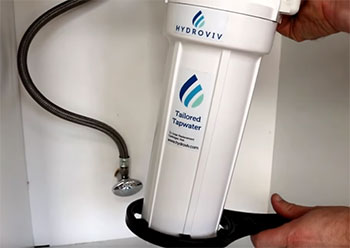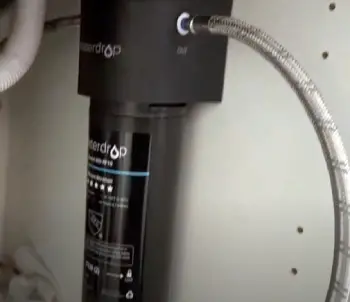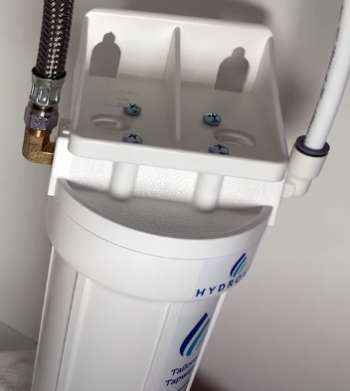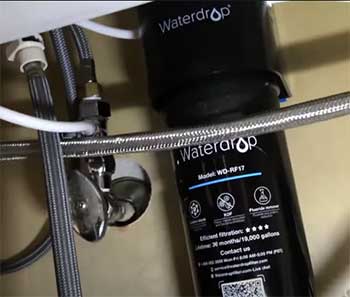I’ve always been picky about my drinking water, and after moving to a new city with questionable tap quality, I decided it was time to upgrade from my old pitcher filter. I narrowed it down to two heavy-hitters in the under-sink water filtration world: Hydroviv and Waterdrop.
My goal?
Find a system that delivers clean, great-tasting water without breaking the bank or complicating my life. In this article, I’ll walk you through my experience comparing these two brands, breaking down their features, pros, cons, and which one might suit you best.
A Brief Comparison Table
| Feature | Hydroviv | Waterdrop G3P800 |
| Filtration Type | Custom multi-stage (no RO) | 8-stage with reverse osmosis (RO) |
| Contaminants Removed | 100s, tailored to local water quality | 1000+ including fluoride, lead, PFAS |
| Installation | DIY, no drilling, uses existing faucet | Requires dedicated faucet, drilling |
| Filter Life | 6 months (avg.) | 6-24 months (depending on filter) |
| Maintenance Cost | Higher (custom filters) | Moderate (standardized filters) |
| Smart Features | None | LED display for TDS & filter life |
| Warranty | 1-year limited, 30-day guarantee | 1-year, 30-day money-back |
| Price (Base System) | ~$200-$300 | ~$500-$1000 |
| Water Waste | None | 1:1 waste ratio (better than most RO) |
| Customization | High (based on zip code) | None |
Why I Chose To Compare Hydroviv And Waterdrop?

When I started my search for a reliable under-sink water filter, I wanted something effective, easy to install, and tailored to my needs.
My tap water had a faint metallic taste, and I’d read enough about PFAS and lead to know I needed serious filtration.
Hydroviv caught my eye with its custom approach, promising filters designed for my specific zip code. Waterdrop, on the other hand, boasted advanced technology and a sleek design.
Both seemed promising, but I needed to dig deeper to see which one would work for me—and maybe for you, too.
My Journey With Water Filtration
I’ve been through the wringer with water filters. I started with a basic pitcher years ago, which was fine for a college dorm but felt inadequate for my family’s needs now.
Tap water quality varies wildly depending on where you live, and after noticing an odd taste in my new home, I started researching contaminants like lead, chlorine, and those pesky “forever chemicals” (PFAS).
I wanted a system that could handle whatever my local water threw at it without requiring a PhD to install or maintain. That’s when I stumbled across Hydroviv and Waterdrop, two brands that kept popping up in reviews and forums.
Hydroviv: The Custom Contender
Hydroviv’s pitch is unique: they don’t sell one-size-fits-all filters. Instead, they analyze water quality reports from your area—down to your zip code—and build a filter tailored to your local contaminants.
As someone who’s skeptical of generic solutions, this hooked me immediately. Their under-sink system uses a multi-stage filtration process, combining activated carbon and other media to tackle things like lead, arsenic, VOCs, and PFAS.
They’re upfront about what they don’t remove, like fluoride, citing that it would compromise performance against more harmful contaminants.
Pros of Hydroviv
- Customized Filtration: The idea of a filter designed for my city’s water issues felt like a game-changer. They pull data from local, state, and federal sources to target specific contaminants.
- Easy Installation: I’m no plumber, but I had their under-sink system up and running in about 15 minutes. No drilling, no extra faucet—just screw it onto my existing setup.
- No Water Waste: Unlike reverse osmosis systems, Hydroviv doesn’t waste water, which aligns with my eco-conscious side.
- Subscription Convenience: They send replacement filters automatically every six months, so I don’t have to remember to reorder.
- Shower Filter Option: I didn’t expect to care about this, but their shower filter made my hair and skin feel noticeably better.
Cons of Hydroviv
- Expensive Filters: The custom filters aren’t cheap, and you can only buy them directly from Hydroviv. This drove up my long-term costs compared to other brands.
- No Fluoride Removal: If fluoride is a concern for you, Hydroviv won’t help. They’re firm on prioritizing other contaminants.
- No Smart Features: There’s no fancy display or app to tell me about filter life or water quality. I have to trust their subscription timing.
- Limited Warranty: The one-year limited warranty felt a bit stingy, and some users report issues claiming it.
Waterdrop: The Tech-Savvy Powerhouse

Waterdrop, founded in 2015, takes a different approach with its G3P800 under-sink system.
It’s a tankless reverse osmosis (RO) system with an 8-stage filtration process that claims to remove over 1,000 contaminants, including fluoride, lead, and PFAS.
What grabbed my attention was the smart LED display on the faucet, showing real-time TDS (total dissolved solids) levels and filter life.
It felt like a high-tech gadget for my kitchen, which I’ll admit was pretty appealing.
Pros of Waterdrop
- Comprehensive Filtration: The 8-stage process, including RO and UV purification, is a beast. It tackles nearly every contaminant I worried about, including fluoride.
- Smart Features: The LED display is a nice touch, letting me see when filters need replacing and how clean my water is.
- Efficient Water Use: With a 1:1 waste-to-purified water ratio, it’s more eco-friendly than older RO systems that waste four gallons for every one purified.
- Remineralization: It adds back beneficial minerals like calcium and magnesium, which improved the taste of my water noticeably.
- Strong Customer Support: Waterdrop’s warranty and support got better reviews, with clear coverage for defects and a responsive team.
Cons of Waterdrop
- Complex Installation: I had to drill a hole for the dedicated faucet, which was a hassle. If you’re not handy, you might need a plumber.
- Higher Upfront Cost: The G3P800’s price tag (around $500-$1000) made me wince, especially compared to Hydroviv’s lower entry point.
- Dedicated Faucet Required: Unlike Hydroviv, you can’t use your existing faucet, which cluttered my sink area.
- Noise: The system makes a slight hum when dispensing water, which annoyed me at first but faded into the background over time.
Key Features of Hydroviv And Waterdrop Breakdown
Let’s get into the meat of what makes these systems tick. I wanted to know exactly what I was getting for my money, so I broke down the key features that mattered to me.
- Filtration Technology

Hydroviv’s multi-stage system uses activated carbon and other media tailored to your local water quality.
It’s NSF-certified for Standards 42 (aesthetic effects like chlorine) and 53 (health effects like lead and PFAS).
The customization is a big selling point—my filter was designed to tackle the high lead levels reported in my area.
However, it skips reverse osmosis, which means it keeps essential minerals but doesn’t remove fluoride.
Waterdrop’s G3P800, on the other hand, is a filtration juggernaut.
Its 8-stage process includes sediment filters, activated carbon, RO, UV purification, and remineralization. It’s also NSF-certified and claims to remove over 1,000 contaminants, including fluoride, which was a plus for me since my city adds it to the water.
The UV stage kills bacteria and viruses, making it ideal if you’re on well water or in an area with microbial concerns.
- Installation and Setup
I’m not a DIY guru, so ease of installation was huge for me. Hydroviv was a breeze—I connected it to my existing faucet with no tools beyond a wrench. The instructions were clear, and I didn’t need to alter my sink setup. It felt like plugging in a new appliance.
Waterdrop was a different story. The G3P800 requires a dedicated faucet, which meant drilling a hole in my countertop. The process took about an hour, and I had to watch a YouTube tutorial to get it right. If you’re renting or don’t want to modify your kitchen, this could be a dealbreaker.
- Maintenance and Costs
Hydroviv’s custom filters need replacing every six months, and they’re pricey since you can only get them from the company. I appreciated the subscription service, which emails me when it’s time to swap filters, but the cost adds up. For a household of four, I estimated about $100-$150 per year on replacements.
Waterdrop’s filters last longer—6 to 24 months depending on the component—but the upfront system cost is higher. Replacement filters are more affordable and standardized, so you’re not locked into buying from Waterdrop. My annual maintenance cost was closer to $80-$120, which felt more manageable.
- Water Quality and Taste
Both systems delivered on taste. Hydroviv’s water was crisp and clean, with no metallic aftertaste. Since it doesn’t use RO, it retains natural minerals, which I think gave it a slight edge in flavor.
Waterdrop’s remineralization stage also produced great-tasting water, but I noticed a subtle difference—almost too “pure” at first, though I got used to it. Both removed the chlorine smell I’d noticed in my tap water, and I felt confident drinking from either.
- Environmental Impact
As someone who tries to reduce waste, I appreciated Hydroviv’s zero-waste approach. RO systems, even efficient ones like Waterdrop’s, produce wastewater. The G3P800’s 1:1 ratio is better than older models, but it still felt less eco-friendly. If sustainability is a priority for you, Hydroviv might align better with your values.
My Experience Using Hydroviv
I started with Hydroviv because the idea of a custom filter intrigued me. After entering my zip code on their website, I got a breakdown of my local water issues—lead and VOCs were the big ones. The filter arrived with a detailed report, which made me feel like I was getting something tailored just for me.
Installation was straightforward, and within 20 minutes, I was drinking filtered water from my kitchen faucet.
The water tasted fantastic, and I noticed my skin felt less dry after showers with their shower filter. However, I was annoyed that I couldn’t track filter life without relying on their emails.
The cost of replacement filters also gave me pause—$50-$75 every six months isn’t trivial. Still, the peace of mind knowing my water was free of lead and PFAS was worth it.
My Experience Using Waterdrop

Switching to Waterdrop was a bigger commitment.
The G3P800 arrived in a sleek box, and the smart faucet looked like something from a sci-fi movie.
Installation was trickier—I cursed a few times while drilling—but once set up, the system felt like a premium addition to my kitchen.
The LED display was a fun perk, showing me real-time TDS levels (usually around 10-20 ppm, which is excellent).
The water quality was top-notch, and I liked that it removed fluoride, which I’d been researching due to mixed opinions on its safety. The system’s hum was noticeable but not a dealbreaker. My biggest gripe was the dedicated faucet, which clashed with my sink’s aesthetic.
Maintenance costs were lower than Hydroviv’s, but the upfront price stung.
Comparing Performance In Real Life
To test both systems, I used them for a month each and paid attention to taste, flow rate, and ease of use. Hydroviv’s flow was slightly faster since it doesn’t use RO, which can slow things down. Waterdrop’s flow was decent but not as instant.
Both systems handled my family’s daily needs—cooking, drinking, and filling water bottles—without issues.
I also sent water samples to a local lab (because I’m that paranoid). Both filters significantly reduced lead and chlorine levels, but Waterdrop’s RO system edged out Hydroviv in removing trace fluoride and nitrates.
However, Hydroviv’s targeted approach meant it was just as effective for my area’s specific contaminants.
Which Is Better For You?

Choosing between Hydroviv and Waterdrop depends on your priorities.
If you want a hassle-free setup and customized filtration, Hydroviv is hard to beat.
It’s ideal for renters or anyone who doesn’t want to modify their kitchen.
The eco-friendly design and shower filter option are bonuses, but be prepared for higher maintenance costs and no fluoride removal.
Waterdrop is for those who want cutting-edge tech and don’t mind a more involved installation. The G3P800’s comprehensive filtration and smart features make it a powerhouse, especially if fluoride or microbial contaminants are concerns.
It’s pricier upfront, but long-term costs are lower, and the warranty is more reassuring.
For me, Hydroviv won out because I valued the easy installation and zero waste. But if I lived in an area with more complex water issues, like well water or high fluoride, I’d lean toward Waterdrop.
Frequently Asked Questions (FAQ)
Yes, Waterdrop filters, especially the G3P800, are excellent, removing over 1,000 contaminants with an 8-stage RO system. They’re reliable but require a dedicated faucet.
Hydroviv is great for tailored filtration, targeting local contaminants like lead and PFAS. It’s easy to install but doesn’t remove fluoride and has pricier filters.
Hydroviv’s founder, Dr. Eric Roy, pitched on Shark Tank in 2019 and secured a deal with Mark Cuban for $400,000 for 10% equity, boosting the brand’s growth.
Waterdrop was founded in China in 2015 but operates globally, focusing on innovative filtration technology and partnerships like the Water4Smile program.
Conclusion: Your Path To Cleaner Water
You’ve got two solid options in Hydroviv and Waterdrop, each with its own strengths. I found Hydroviv’s custom approach and easy setup perfect for my needs, but Waterdrop’s tech-heavy, comprehensive filtration is a strong contender if you’re after maximum contaminant removal.
Think about your budget, water quality concerns, and whether you’re okay with a bit of DIY. Whichever you choose, you’re taking a big step toward safer, tastier water.
Let me know in the comments which one you’re leaning toward—I’d love to hear your thoughts!
